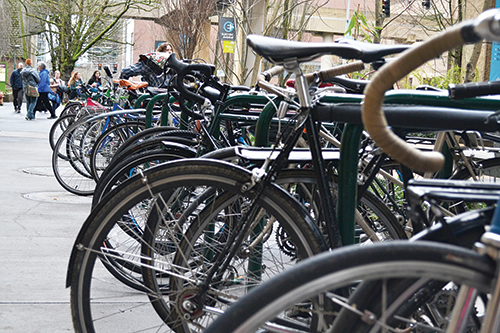
Bike racks like this one, located between Smith Memorial Student Union and Cramer Hall, can be found all over campus and increasingly around Portland. Photo by Risa Liu.
Non-car-users spend more money than drivers at Portland businesses, PSU’s Oregon Transportation Research and Education Consortium found in a report last month.
The OTREC report, titled “Consumer Behavior and Travel Mode Choices,” takes a look at the relationship between Portland businesses and the way their customers travel to them.
For example, the study found that restaurants saw more transit-using customers and fewer drivers. A transit user frequents a restaurant an average of eight times per month and spends about $50 total during those visits.
Comparatively, drivers frequent restaurants between two and three times per month, but spend the most per visit out of any other customer, with an average of $19.
“It was interesting to me to see that people who took transit and walked were just as competitive of consumers as those who drove, contrary to how businesses think,” said Christopher Muhs, a graduate research assistant in the engineering program.
According to Muhs, the study was initiated by the city and several
businesses to provide structure for alternatives to driving.
“Not much research has been done on this in the United States, and we wanted to look into what alternatives businesses should cater to…and what policies they should alternate,” Muhs said.
OTREC Communications Director Justin Carinci explained that business owners sometimes worry that sales will drop as more people leave their cars behind.
“There was little research we could point to that would prove this isn’t the case,” he said.
To get this information, a team directed by Kelly Clifton, associate professor in the Civil and Environmental Engineering Department, surveyed 1,884 people at 89 businesses and found that many factors influence how much a person spends at a particular place—including how far a person has to travel to get to his or her destination.
Most of the businesses looked at by the study were food-related, such as restaurants and bars, but convenience stores were also included.
Supermarkets tend to see more money spent in one trip from automobile users. Since pedestrians often have to make multiple trips to get all the groceries they need, however, they actually spend more money on a monthly basis.
Pedestrians also spend more money at businesses that serve alcohol and food, shelling out an average of $22 per trip. Bicyclists spend even more money at drinking establishments, spending an average of $82 per month.
Traveling within Portland has changed drastically in the past 30 years. Many have given up driving in favor of cheaper ways to travel, like biking and public transportation.
Portland businesses, however, aren’t quite in tune with this trend. They have continued their efforts to appeal to drivers without making new efforts to meet the specific needs of walkers and bikers.
During the study, Muhs helped with data collection and design; he also helped create the data report. He believes that this study will help Portland businesses better understand their customers, and that the city will see more businesses cater to driving alternatives in the future.
“Lots of businesses already have bike racks,” Muhs said. “As more businesses catch on to this trend, they will add themselves to a wait-list to get racks from the City of Portland and will wait about a year to get some installed.
“Portland can now look into consumer transportation patterns, and more studies on this sort of thing will probably be made,” he added. “We are on the right track.”
Employees of the Bike Hub, PSU’s on-campus bike shop specifically catering to students, faculty and staff, are optimistic that the city will continue to become even more bike-friendly.
For some students, riding bikes to campus is a more affordable travel option than driving or riding the bus, with the cost of gas and TriMet passes.
Bike Hub supervisor Clint Culpepper said the shop is hoping to see more cycletracks—separate bike lanes—on Portland streets, like the one on Southwest Broadway.
“Cycletracks are seen all over Europe, and studies have shown that they’re preferable to not only cyclists, but drivers as well,” Culpepper said. “As the study has shown, it’s important to locate the bicycle infrastructure with commercial activity in mind.”
Safety for bike riders is another concern that Bike Hub employees would like to see addressed in the future.
“We would love to see continued improvement in the bicycle infrastructure,” he said. “The projects that the city has undertaken have really been the motivating factor for many new cyclists. Safety concerns are always the number one reason that people give for not riding, so anything that we can do to improve the safety of our bicycle network would be much appreciated.”
The study is available to download online at otrec.us/project/411.

